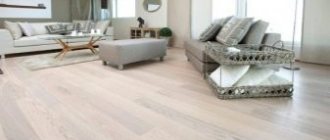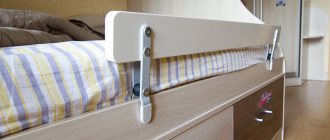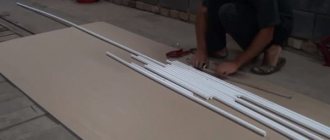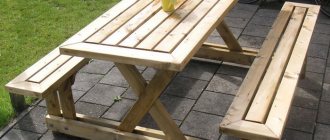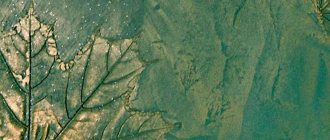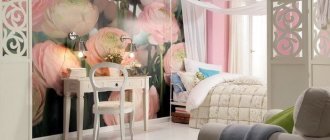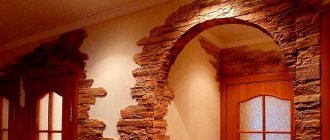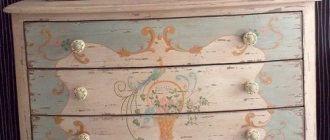Liquid wallpaper Paintings from them, the design of which is not so complicated, will emphasize the individuality of each room and allow you to realize the most extraordinary ideas. We create paintings for the interior from liquid wallpaper: technology, design, general recommendations
You can create a wide variety of pictures from liquid wallpaper: your home will become unique. In the modern world there is a huge selection of wall decoration and decoration. Combining wallpaper is one of the most popular Western trends, which is a simple and affordable way to decorate. By combining wallpaper of different textures and colors, using liquid wallpaper, you can transform the interior and create an accent in any room.
Wallpaper paintings in the interior: variety and practicality
The paintings themselves are an independent decoration in the room and create additional comfort if stylistically chosen correctly. Using the remnants of wallpaper that remain after all the finishing work, you can create original design solutions yourself: framed paintings, modular paintings, panels, false panels, patchwork paintings in the patchwork style
Drawings with liquid paintings on wallpaper are becoming quite popular: they can be applied even to an imperfectly flat wall
Wallpaper decor allows you to solve a number of functional problems:
- Hide wall defects and layout flaws (visually expand a small room, change the proportional ratio of the width and height of the wall, smooth out the effect of too high ceilings);
- Divide the space into functional zones (relevant for studio layout);
- Create a general concept for the entire room without losing the individuality of each individual room;
- Break up the monotony and highlight the main walls artistically.
Pictures framed from wallpaper
The technique is simple to implement: the wallpaper is pasted onto hard cardboard and framed using a strip, plinth, or molding (an overlay convex strip for decorating surfaces). The main nuance: wallpaper paintings should be consistent in color with the decor of the room. Paintings with expressive designs - bright colors, geometric shapes, elegant patterns - look most advantageous.
Wallpaper panel
Such paintings differ from previous ones only in the absence of a frame. When performing work, the wallpaper is glued to a panel (cardboard, plywood, chipboard) with an allowance so that the edges are turned to the reverse side.
If you want your interior to look modern and stylish, then panels with 3D wallpaper are suitable for you.
To imitate the 3D Wallpaper technique (3D wallpaper), a panel is created from the same wallpaper that decorates the entire wall.
False panels
To change the design of the room without resorting to major renovations, you can decorate the walls with new wallpaper panels. It is enough to paste the wallpaper segments onto the old finish and, after drying, highlight the borders with frames. New “panels” only occupy part of the wall, so they must be consistent with the main wallpaper and the overall style of the room.
Lovers of the bright and extraordinary can use the patchwork technique (patchwork finishing in sewing, which can be used for interior decoration).
The patchwork method is an original way to decorate your home: in addition, wallpaper created using this method has a fairly low cost
Using leftover wallpaper in the form of appliqués, paintings, decorative elements, and patchwork walls are created. A children's room can be an excellent platform for creativity in the patchwork style. For example, create fragments of fairy tales or cut out circles of different diameters from wallpaper and chaotically glue them onto the main wall decoration and get a room with polka dots.
Using liquid wallpaper in the interior of an apartment
Rooms with liquid wallpaper that combines gold and silver threads will look great. Using color transitions, you can highlight a certain area of the room and create an accent.
Some types of canvases contain natural silk, which creates the illusion that real textile wallpaper is pasted on the walls. This design option is suitable for creating a boudoir atmosphere in the bedroom.
14
This type of wallpaper in the interior can be used for zoning rooms. Very often they are used to design a children's room. If your child likes pirates or sea adventures, you can depict a real seascape on the walls. And if a little princess lives in the room, the walls can be decorated with flowers, butterflies, the sun, a house or little animals.
In the bedroom, landscapes can be more serious. For example, you can paint a picture of a sunset or sea waves.
Liquid wallpaper for the kitchen must be treated with protective agents
Interesting large pattern of liquid wallpaper
Home billiard room in a classic style with soft sand walls and ceiling
Liquid wallpaper for the ceiling
The ceiling is a problematic area in every apartment, and if people move into a new home, one of the tasks is to make the ceiling covering look beautiful. In practice, situations often arise when defects (unevenness, roughness) are visible on the ceiling, and a lot of money is spent on leveling. Therefore, not only the finishing of liquid walls with wallpaper is used, but also the treatment of ceilings. When using a wide range of shades, it will not be difficult for the user to recreate beautiful and original designs, patterns, and ornaments. The advantage of decorative material for ceilings is that there is no fear of any temperature environment, so you can decorate the ceilings with such a coating in the kitchen and bathroom.
The combination of white and red liquid wallpaper in the decoration of walls and ceilings
According to reviews, this decor looks solid and demonstrates all the luxurious taste and wealth of the owners. The only thing worth considering as a disadvantage is the high cost. But this will compensate for the costs of smoothing out joints and bubbles, since the material will not crumble and will last for a long time. You can learn how to apply liquid wallpaper to drywall, as well as other types of surfaces, without compromising their quality parameters. This will only take a few hours, while a similar process with ordinary wallpaper will take at least 2-3 days.
Liquid wallpaper on the ceiling in two delicate shades
Catalog of liquid wallpaper
Currently, the market offers many solutions related to the application of liquid wallpaper. Each apartment owner has a huge selection of options. These can be budget materials with simple application technology and design, or there can also be more complex options, for example, entire paintings made from liquid wallpaper. By looking at photos of numerous interiors that are made using such finishing solutions, you can achieve a positive result and choose a solution for a home, apartment, or even a commercial establishment. A variety of colors will allow you to choose options for any interior and any style.
Beautiful combination of blue wallpaper and bright blue mirror frame
Silk liquid wallpaper
Before making a final decision on the use of silk wallpaper in the interior of your room, you need to generally take into account their basic characteristics so that there are no difficulties with application. For the sake of information, it is worth noting that in addition to liquid wallpaper, paper and vinyl can also be silk - their top layer is made from silk raw materials. These structures act as an analogue of decorative plaster, so the material belongs to the universal class. It can be used in residential, commercial, administrative and even public premises. Such liquid wallpaper is used in the interior of the living room and other rooms. The popularity of silk products has increased due to their affordable price and numerous advantages:
Silk liquid wallpaper in beige tones with gold threads
Liquid wallpaper is a fairly durable finishing material
Why choose silk liquid wallpaper
Such liquid wallpaper in the interior of a kitchen, living room, hall, bedroom, bathroom, attic, attic will look great and will be suitable even for those rooms that have a non-standard type and layout principle. If you want to get a modern, exclusive design, stylizing it to match any avant-garde or classical direction of interior art, you will certainly like the purchase of such finishing materials.
Liquid wallpaper will help hide wall imperfections
Stencils for liquid wallpaper
Using well-chosen materials, each user will be able to create individual drawings. The materials are sold in dry form, and for full use you will have to dilute them with a certain amount of water. Thanks to original and attractive designs, you can solve several problems at the same time - filling all the cracks, eliminating any cracks that exist on the surface. The products have excellent elasticity and prevent any shrinkage, so even a beginner can independently create liquid wallpaper on plaster and other materials.
Interesting kitchen apron decor using liquid wallpaper
Options for proposed stencils
Stencils provide a solution to the problem of making your own designs. You can make them yourself or purchase them ready-made. In the first case, you save money, in the second, you save your own time. Today, it will not be difficult for users to choose a huge variety of stencils for liquid wallpaper for their space, and they are offered in several varieties:
Wall decoration with liquid wallpaper in the interior of the salon
You can create designs from liquid wallpaper with your own hands and make the interior as attractive as possible.
Patterned sophisticated stencil for applying liquid wallpaper to the wall
It is important to know! Using this material for painting in the interior, you can select separate zones, relieving the space from additional overloads.
Modular paintings: a current decorative element
Modular paintings are a whole composition that is divided into several paintings (panels), united by one concept, color scheme or general sketch. In other words, it's one big picture divided into segments.
Modular paintings can be created from leftover wallpaper
There are many variations in the design of modular paintings:
- Modular compositions can include from two paintings to infinity;
- The size of the segments is created either of the same size or different;
- The paintings are placed on the same level or randomly.
This is a very impressive interior detail, so most often modular paintings are hung on empty plain walls so that extraneous details do not distract attention from the composition.
Do-it-yourself paintings from leftover wallpaper: execution technology
It’s quite easy to create paintings from wallpaper yourself. We carefully think through all the details of the composition so that the painting fits harmoniously into the interior.
Plywood sheet is the most durable base for paintings
Basic stylistic rules for combining wallpaper:
- It is best to select wallpapers of the same quality, which differ in color, texture and composition.
- To avoid uneven joints and problems with framing, the thickness of the wallpaper should be approximately the same.
- Wallpaper compositions are selected to match the style of the room or are correlated with individual interior details (a combination of shades of different colors, general patterns and ornaments, bright colors that complement each other in contrast, geometric shapes combined with abstraction).
Next, we select any dense base onto which we carefully glue the wallpaper composition. The base can be hard cardboard, chipboard, or polystyrene foam (bulk foam sheets are perfect for creating panels and modular paintings). Using available tools: scissors, glue, stencils and pins, we create a picture.
It is worth paying attention to the fastening. Depending on the weight, desired design, and intended mobility of the painting, fastening brackets, double-sided tape, liquid nails, hooks glued to the wall, polymer glue or the Command system (Velcro for the wall and painting) are used.
How to choose liquid wallpaper
Liquid wallpaper creates interior design at its best, but you need to learn how to choose them wisely. When choosing suitable wallpaper for your interior, you should pay attention to several main factors:
Liquid wallpaper is used in the decoration of almost all rooms, even in dressing rooms
Taking into account the level of professionalism, products are selected in finished form or those that need to be completed with one’s own hands. Depending on the material, you can give preference to silk or cellulose products, as well as combined options. The cost depends on the consumer characteristics of the wallpaper and its type. On average, it is high, and design experts do not recommend saving on them. Based on the style of the room, certain options are also selected. Sometimes you can only buy white liquid wallpaper for the interior, although the modern industrial sector offers a lot of types.
The mixture for liquid wallpaper contains harmless decorative fiber components, so they can be safely used when decorating walls in the bedroom
Trowel for liquid wallpaper
The application of such material is traditionally carried out using a transparent trowel, thanks to which the patterns and layers of the plaster material can be adjusted. Leveling the entire canvas is done using a grater - a special plastic trowel. You can purchase this toolkit at a specialized store.
Spectacular do-it-yourself paintings from liquid wallpaper
Finishing material such as liquid wallpaper is becoming increasingly popular.
This is the final decorative coating for walls and ceilings, which has a number of advantages over rolled wallpaper and decorative plaster.
The highest quality wall decoration - relief paintings from liquid wallpaper
- Liquid wallpaper does not form joints when applied;
- Level walls and hide flaws;
- Eco-friendly, with high sound insulation;
- They can be repeatedly transferred to other walls without losing their qualities.
However, liquid wallpaper has a long drying time (up to two days after application).
Liquid wallpaper is a material that allows you to create paintings, panels and paint walls. This is a labor-intensive process, but we can do it ourselves.
How to make a picture using liquid wallpaper:
- Prepare the walls according to the wallpaper instructions;
- Draw the outline of the sketch on the wall in a convenient way (with a pencil, through a stencil, using glass and a lamp);
- Dilute liquid wallpaper to the desired consistency (colors are added to create the desired shade);
- Using a spatula, apply the mixture up to 2 mm thick onto the corresponding segment of the pattern, forming boundaries;
- Allow the pattern fragment to dry completely (the mixture of different colors should not touch each other if the pattern has clear outlines);
- After all the fragments have been processed with the mixture, adjust all parts of the picture using pencils or felt-tip pens.
Liquid wallpaper allows you to individually design your interior, be it a nursery, hallway or kitchen.
Liquid wallpaper - silk plaster Silk Plaster, questions and answers!
- First, on a wall that has already been prepared for wallpapering, we make a drawing with an ordinary pencil; it is not painted and cannot in any way affect the color of our liquid wallpaper in the future.
- Then we will need to apply the liquid wallpaper material so that it protrudes beyond the contours of the elements of the resulting pencil drawing by approximately 2 millimeters. The thickness of the liquid wallpaper layer should be approximately 2-3 millimeters.
- After this procedure (the most important and simplest when creating patterns with wallpaper), we will need a small rubber spatula (so that the width of the spatula is approximately 4-5 centimeters), or the edge of a plastic trowel (everything will depend on the size of the pattern and its complexity ), we will move all the liquid wallpaper material that is knocked out (extends) beyond the contour of the drawing inside our pencil contour until the border of the pencil drawing applied to the wall in step 1 appears. If it turns out that a lot of wallpaper material begins to accumulate along the edges of the picture, it’s okay: with a plastic trowel you will need to smooth out all the accumulations of material towards the center of the picture (we remove all the excess accumulated liquid wallpaper from the inside of the picture).
- Now we will need to wait a short amount of time for the drawing to dry a little and the liquid wallpaper to harden a little. It doesn’t take much time; to speed up drying, you should use accelerated air circulation (just open the window for a draft) or other ways to speed up the drying process of liquid wallpaper, for example, dry it or use a fan. The drying time for the edge of the outline of our pattern will be approximately 3 hours . If the pattern is small in volume, you can use a hair dryer - this will not affect the quality of the liquid wallpaper at all, and will greatly save time on drying. When the contour dries, this will allow you to easily combine it with the next type of liquid wallpaper to obtain a beautiful composition without mixing the wallpaper.
- As soon as our outline of the liquid wallpaper pattern has dried, we can apply the next layer of wallpaper next to the already finished one, the application technology is exactly the same. You only need to remember that it is better to apply the next layer of wallpaper next to the already finished ones at a short distance, so that when smoothing it prevents some wallpaper from overlapping others. It should be applied in a layer of the same thickness.
- If you need to highlight something separately in the drawing, you can use a marker, add sparkles, beads and any other decorations to the liquid wallpaper; you can hardly limit yourself to anything here; Despite the fact that liquid wallpaper is a completely environmentally friendly material, the adhesive properties of liquid wallpaper are extremely reliable and they will perfectly adhere to various additional decorations, be it beads or tinsel.
Now your liquid wallpaper drawing is ready! You can participate in Silk Plaster competitions, or simply enjoy the beauty of your drawing and show all your friends and acquaintances what you have learned to do with Silk Plaster!
Creating applications on top of a layer of liquid wallpaper
There is also the possibility of creating applications on top of an already finished layer of liquid wallpaper on the wall. Creating applications is very similar to creating a pattern with liquid wallpaper in its technology, but it will be very difficult for non-professionals, for the reason that:
- If the top layer extends beyond the outline of the design, the wallpaper will paint each other, so high precision and above average application skill will be required.
- About 5 minutes after wetting with water, the bottom layer of liquid wallpaper will become soaked and deformed, and when pressure is applied to it, it can become severely deformed.
We recommend that everyone try creating a pattern with liquid wallpaper! If any difficulties arise, the material can always be removed and reused. The main rule here is to prepare the wall well for applying liquid wallpaper. Experiment with liquid wallpaper! Creating a pattern with liquid wallpaper is easy!
How to apply liquid wallpaper to a wall (video)
Before using liquid wallpaper or remnants of rolled wallpaper, it is worth understanding what accents your interior lacks: bright colors or sophisticated details, consistency between furniture and walls, or new images. All this can be done independently at minimal cost, using the ideas discussed.
How to make modular paintings with your own hands from photo wallpaper
